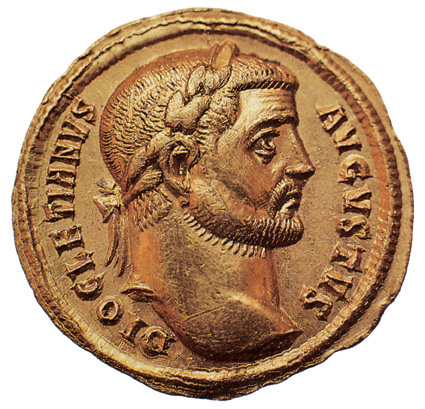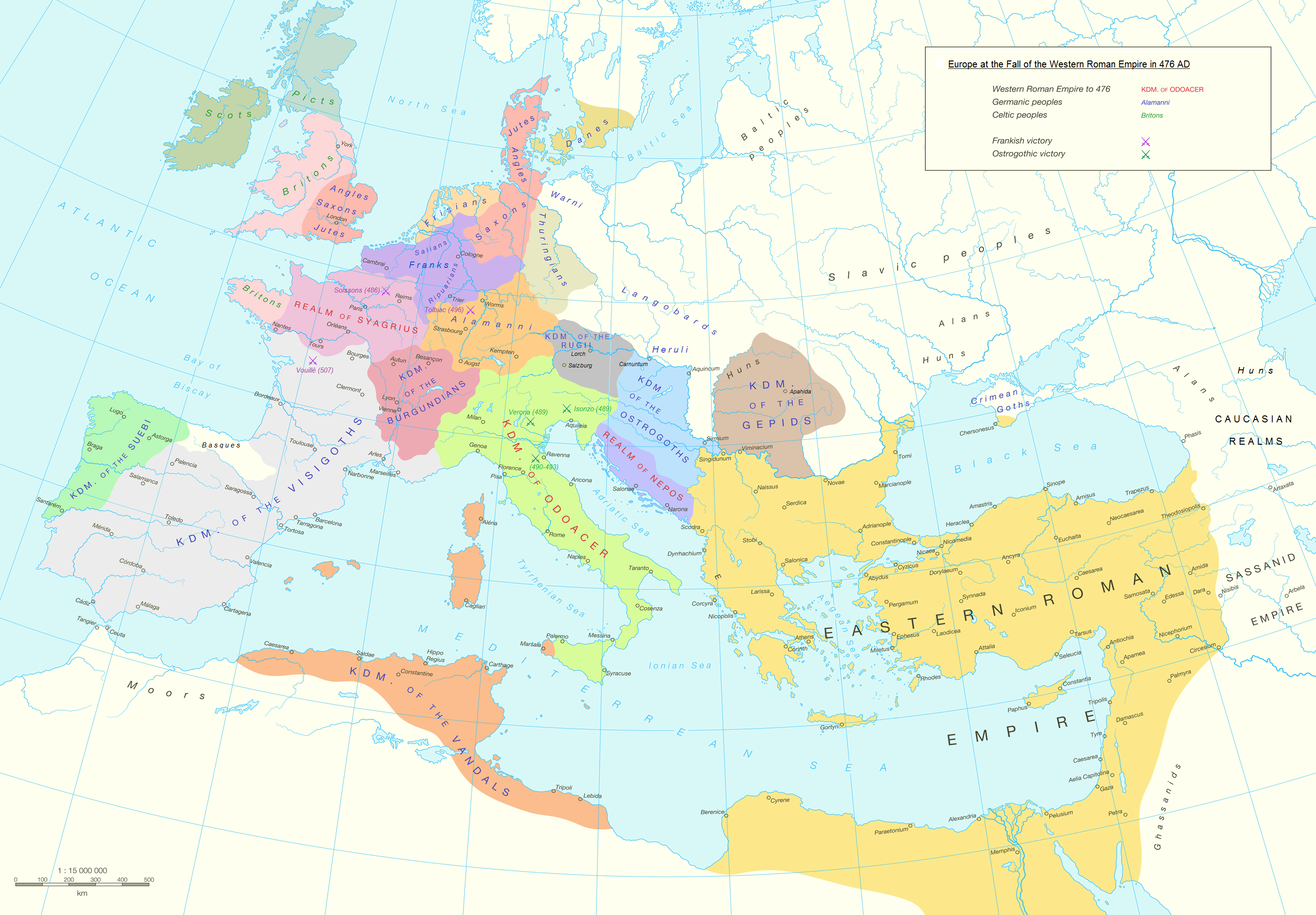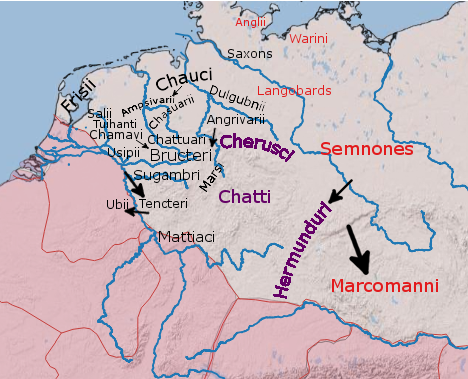|
Astingi
The Hasdingi were one of the Vandal peoples of the Roman era. The Vandals were Germanic peoples, who are believed to have spoken an East Germanic language, and were first reported during the first centuries of the Roman empire in the area which is now Poland, eastern Germany, the Czech Republic, and Slovakia. Famously, the Hasdingi led a successful invasion of Roman North Africa, creating a kingdom with its capital at Carthage in what is now Tunisia. During the Marcomannic wars, the Hasdingi helped the Romans and were able to settle in the Carpathian and Pannonian areas which are now in Hungary and Romania. At the end of 405, they participated together with Silingi Vandals and Sarmatian Alans in the crossing of the Rhine. Their king Godigisel lost his life in battle against the Franks during the crossing. After some years in Gaul, these peoples moved into the Iberian peninsula. The Hasdingi settled in Gallaecia (today Galicia, Asturias and the north of Portugal) along with the ... [...More Info...] [...Related Items...] OR: [Wikipedia] [Google] [Baidu] |
Marcomannic Wars
The Marcomannic Wars (Latin: ''bellum Germanicum et Sarmaticum'', "German and Sarmatian War") were a series of wars lasting from about 166 until 180 AD. These wars pitted the Roman Empire against, principally, the Germanic Marcomanni and Quadi and the Sarmatian Iazyges; there were related conflicts with several other Germanic, Sarmatian and Gothic peoples along both sides of the whole length of the Roman Empire's northeastern European border, the river Danube. The struggle against the Germans and Sarmatians occupied the major part of the reign of Roman emperor Marcus Aurelius, and it was during his campaigns against them that he started writing his philosophical work ''Meditations''. Background Secure for many years following his ascension to power, the Roman Emperor Antoninus Pius never left Italy; neither did he embark on substantial conquests, all the while allowing his provincial legates to command his legions entirely. Historian Adrian Goldsworthy posits that Pius's rel ... [...More Info...] [...Related Items...] OR: [Wikipedia] [Google] [Baidu] |
Vandals
The Vandals were a Germanic people who first inhabited what is now southern Poland. They established Vandal kingdoms on the Iberian Peninsula, Mediterranean islands, and North Africa in the fifth century. The Vandals migrated to the area between the lower Oder and Vistula rivers in the second century BC and settled in Silesia from around 120 BC. They are associated with the Przeworsk culture and were possibly the same people as the Lugii. Expanding into Dacia during the Marcomannic Wars and to Pannonia during the Crisis of the Third Century, the Vandals were confined to Pannonia by the Goths around 330 AD, where they received permission to settle from Constantine the Great. Around 400, raids by the Huns from the east forced many Germanic tribes to migrate west into the territory of the Roman Empire and, fearing that they might be targeted next, the Vandals were also pushed westwards, crossing the Rhine into Gaul along with other tribes in 406. In 409, the Vandals c ... [...More Info...] [...Related Items...] OR: [Wikipedia] [Google] [Baidu] |
Godigisel
Godigisel (359–406) was King of the Hasdingi Vandals until his death in 406. It is unclear when or how he became king; however, in 405 he formed and led a coalition of Germanic peoples, including the Hasdingi Vandals, Silingi Vandals, Suebi, and others from Pannonia with the intention of invading Roman Gaul. Before crossing the Rhine River into Gaul, he was killed in the Vandal–Frankish war, possibly in late 406. Shortly after his death (traditionally dated to 31 December 406), this group of Vandals and their allies crossed the Rhine River into the territory of the Roman Empire, possibly while it was frozen. Godigisel was succeeded by his eldest surviving son, Gunderic, who led the Vandals into Gaul and in October 409 to Hispania. But Godigisel was best known as the father of Genseric, who succeeded Gunderic to the kingship in 428 and ruled for 49 years, establishing a powerful kingdom in North Africa North Africa, or Northern Africa is a region encompassing the northern ... [...More Info...] [...Related Items...] OR: [Wikipedia] [Google] [Baidu] |
Hermeric
Hermeric (died 441) was the king of the Suevi from at least 419 and possibly as early as 406 until his abdication in 438. Biography Before 419 Nothing is known for sure about Hermeric before 419, the year in which he is first mentioned; namely, he became king of the Suebi (or Suevi) in the city of Braga (Bracara Augusta) according to bishop Hydatius (who wrote his chronicle around the year 470). Although bishop Isidore of Seville, writing his '' Historia de regibus Gothorum, Vandalorum et Suevorum'' two centuries after the fact, claims that Hermeric was already king of the Suebi from 406, Isidore based himself on primarily on Jerome, Hydatius, Prosper of Aquitaine and Orosius, none of whom mentions Hermeric prior to 419. Hermeric was a pagan and an enemy of the Roman Empire throughout his life. He is given a reign of thirty-two years in most manuscripts of Isidore of Seville's '' Historia Suevorum'', but one manuscript does list his reign as fourteen years.Thompson, 1 ... [...More Info...] [...Related Items...] OR: [Wikipedia] [Google] [Baidu] |
Gunderic
Gunderic ( la, Gundericus; 379–428), King of Hasding Vandals (407-418), then King of Vandals and Alans (418–428), led the Hasding Vandals, a Germanic tribe originally residing near the Oder River, to take part in the barbarian invasions of the Western Roman Empire in the fifth century. History He was a son of King Godigisel, the Hasdingi's Vandal king when his people breached the Rhine river frontier of the Empire on the last day of 406. During that year, the Vandals had become heavily involved in a war with the Franks, who were already settled as allies of the Romans, and who attempted to keep the Vandals out. Godigisel was killed in the fighting and Gunderic succeeded him. Gunderic and his people ultimately crossed the Pyrenees into the Iberian Peninsula in October 409. With the Hasdingi portion of the Vandals he established the Kingdom in the Roman province of Gallaecia (north-western Iberia). They were driven out by the Visigoths in 418 on the orders of the Romans (th ... [...More Info...] [...Related Items...] OR: [Wikipedia] [Google] [Baidu] |
Western Roman Empire
The Western Roman Empire comprised the western provinces of the Roman Empire at any time during which they were administered by a separate independent Imperial court; in particular, this term is used in historiography to describe the period from 395 to 476, where there were separate coequal courts dividing the governance of the empire in the Western and the Eastern provinces, with a distinct imperial succession in the separate courts. The terms Western Roman Empire and Eastern Roman Empire were coined in modern times to describe political entities that were ''de facto'' independent; contemporary Romans did not consider the Empire to have been split into two empires but viewed it as a single polity governed by two imperial courts as an administrative expediency. The Western Roman Empire collapsed in 476, and the Western imperial court in Ravenna was formally dissolved by Justinian in 554. The Eastern imperial court survived until 1453. Though the Empire had seen periods wit ... [...More Info...] [...Related Items...] OR: [Wikipedia] [Google] [Baidu] |
Barbarian Kingdom
The barbarian kingdoms, also known as the post-Roman kingdoms, the western kingdoms or the early medieval kingdoms, were the states founded by various non-Roman, primarily Germanic, peoples in Western Europe and North Africa following the collapse of the Western Roman Empire in the fifth century. The formation of the barbarian kingdoms was a complicated, gradual and largely unintentional process, as the Roman state failed to handle barbarian migrants on the imperial borders, leading to both invasions and invitations into imperial territory, but simultaneously denied barbarians the ability to properly integrate into the imperial framework. The influence of barbarian rulers, at first local warlords and client kings without firm connections to any territories, increased as Roman emperors and usurpers used them as pawns in civil wars. It was only after the collapse of effective Western Roman central authority that the barbarian realms transitioned into proper territorial kingdoms. Th ... [...More Info...] [...Related Items...] OR: [Wikipedia] [Google] [Baidu] |
Suebi
The Suebi (or Suebians, also spelled Suevi, Suavi) were a large group of Germanic peoples originally from the Elbe river region in what is now Germany and the Czech Republic. In the early Roman era they included many peoples with their own names such as the Marcomanni, Quadi, Hermunduri, Semnones, and Lombards. New groupings formed later, such as the Alamanni and Bavarians, and two kingdoms in the Migration Period were simply referred to as Suebian. Although Tacitus specified that the Suebian group was not an old tribal group itself, the Suebian peoples are associated by Pliny the Elder with the Irminones, a grouping of Germanic peoples who claimed ancestral connections. Tacitus mentions Suebian languages, and a geographical "Suevia". The Suevians were first mentioned by Julius Caesar in connection with the invasion of Gaul by the Germanic king Ariovistus during the Gallic Wars. Unlike Tacitus he described them as a single people, distinct from the Marcomanni, within t ... [...More Info...] [...Related Items...] OR: [Wikipedia] [Google] [Baidu] |
Portugal
Portugal, officially the Portuguese Republic, In recognized minority languages of Portugal: :* mwl, República Pertuesa is a country located on the Iberian Peninsula, in Southwestern Europe, and whose territory also includes the Macaronesian archipelagos of the Azores and Madeira. It features the westernmost point in continental Europe, its mainland west and south border with the North Atlantic Ocean and in the north and east, the Portugal-Spain border, constitutes the longest uninterrupted border-line in the European Union. Its archipelagos form two autonomous regions with their own regional governments. On the mainland, Alentejo region occupies the biggest area but is one of the least densely populated regions of Europe. Lisbon is the capital and largest city by population, being also the main spot for tourists alongside Porto, the Algarve and Madeira. One of the oldest countries in Europe, its territory has been continuously settled and fought over since prehistoric tim ... [...More Info...] [...Related Items...] OR: [Wikipedia] [Google] [Baidu] |
Asturias
Asturias (, ; ast, Asturies ), officially the Principality of Asturias ( es, Principado de Asturias; ast, Principáu d'Asturies; Galician-Asturian: ''Principao d'Asturias''), is an autonomous community in northwest Spain. It is coextensive with the province of Asturias and contains some of the territory that was part of the larger Kingdom of Asturias in the Middle Ages. Divided into eight ''comarcas'' (counties), the autonomous community of Asturias is bordered by Cantabria to the east, by León (Castile and León) to the south, by Lugo (Galicia) to the west, and by the Cantabrian sea to the north. Asturias is situated in a mountainous setting with vast greenery and lush vegetation, making it part of Green Spain. The region has a maritime climate. It receives plenty of annual rainfall and little sunshine by Spanish standards and has very moderated seasons, most often averaging in the lower 20s celsius. Heatwaves are rare due to mountains blocking southerly winds. ... [...More Info...] [...Related Items...] OR: [Wikipedia] [Google] [Baidu] |
Galicia (Spain)
Galicia (; gl, Galicia or ; es, Galicia}; pt, Galiza) is an autonomous community of Spain and historic nationality under Spanish law. Located in the northwest Iberian Peninsula, it includes the provinces of A Coruña, Lugo, Ourense, and Pontevedra. Galicia is located in Atlantic Europe. It is bordered by Portugal to the south, the Spanish autonomous communities of Castile and León and Asturias to the east, the Atlantic Ocean to the west, and the Cantabrian Sea to the north. It had a population of 2,701,743 in 2018 and a total area of . Galicia has over of coastline, including its offshore islands and islets, among them Cíes Islands, Ons, Sálvora, Cortegada Island, which together form the Atlantic Islands of Galicia National Park, and the largest and most populated, A Illa de Arousa. The area now called Galicia was first inhabited by humans during the Middle Paleolithic period, and takes its name from the Gallaeci, the Celtic people living north of the ... [...More Info...] [...Related Items...] OR: [Wikipedia] [Google] [Baidu] |
Gallaecia
Gallaecia, also known as Hispania Gallaecia, was the name of a Roman province in the north-west of Hispania, approximately present-day Galicia, northern Portugal, Asturias and Leon and the later Kingdom of Gallaecia. The Roman cities included the port Cale (Porto), the governing centers Bracara Augusta (Braga), Lucus Augusti (Lugo) and Asturica Augusta (Astorga) and their administrative areas Conventus bracarensis, Conventus lucensis and Conventus asturicensis. Description The Romans named the northwest part of Hispania or the Iberian Peninsula ''Gallaecia'' after the celtic tribes of the area the Gallaeci or Gallaecians. The Gallaic make their entry into written history in the first-century epic ''Punica'' of Silius Italicus on the First Punic War: :''Fibrarum et pennae divinarumque sagacem'' :''flammarum misit dives Callaecia pubem,'' :''barbara nunc patriis ululantem carmina linguis,'' :''nunc pedis alterno percussa verbere terra,'' :''ad numerum resonas gaudent ... [...More Info...] [...Related Items...] OR: [Wikipedia] [Google] [Baidu] |

.jpg)



